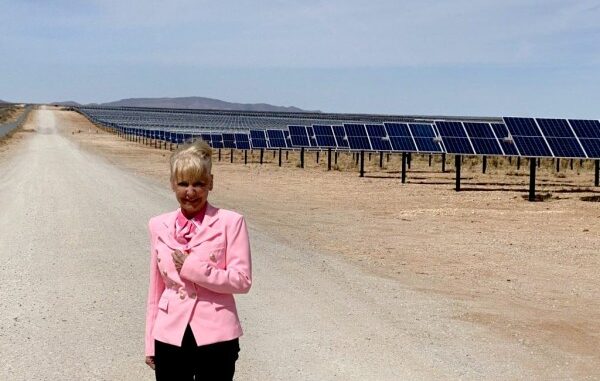
Over the last five years, wind and solar farms have grown exponentially across Texas, transforming the state’s power grid and generating more electricity than ever this year amid the searing summer. The story has been different in El Paso, however.
Last month, solar farms across Texas produced more electricity in June than they did in all of 2018. Wind and solar farms combined last year to produce 31% of the electricity on the power grid that covers most of Texas outside of El Paso – which is operated by the Electric Reliability Council of Texas, or ERCOT – and that’s grown to 35% of the state’s power through the first half of this year.
Yet in the Borderland, less than 3% of the electricity El Pasoans used last year came from renewable energy sources, a figure that pales in comparison to other utilities across both Texas and New Mexico.
A top El Paso Electric executive cautioned against comparing figures from EPE, a monopoly utility overseen by state regulators, to ERCOT, which is a deregulated, competitive market that electricity generators sell power into. Even so, El Paso Electric has initiated plans to shutter some of its aging natural gas power plant units and rely more on solar energy.
Last month, EPE began receiving power from the new Buena Vista solar farm, a 120-megawatt, 900-acre sea of solar panels outside of Chaparral, New Mexico. It’s the utility’s biggest-ever solar facility.
Get connected
Every morning, thousands of energy professionals turn to our newsletters for the day’s most important news. Sign up for free to get the latest delivered straight to your inbox.
And El Paso Electric is planning to develop by 2025 four other big solar farms with 580 megawatts of capacity. The utility is also adding batteries at some of the solar farms to capture solar energy at midday and discharge the power onto the grid in the evening after the sun sets. One megawatt is enough to power a few hundred homes at once, depending on the time of day and temperature.
“We have a plan to get caught up,” Jessica Christianson, EPE’s vice president of sustainability and energy solutions, told El Paso Matters. “And I think that it’s a really methodical plan that takes into consideration the importance of clean energy and the environmental impact of our operations. But concurrently gives us an affordable and reliable solution.”
El Paso’s electricity today is far more likely to come from either the Palo Verde nuclear power plant west of Phoenix – the largest power plant in the country – or from EPE’s fleet of four local natural gas-fired power plants. Nuclear and gas-fired plants produced 84% of the region’s electricity in 2022, according to El Paso Electric.
“Resource mixes are variable between utilities,” said Jon Rea, a senior associate focused on carbon-free electricity with the Rocky Mountain Institute, a nonprofit energy research group based in Colorado. “But El Paso does stand out for having very little wind and solar in comparison to the rest of Texas.”
El Paso Electric in 2016 closed its only coal plant and shifted to heavier reliance on natural gas, which emits about half as much of the greenhouse gas carbon dioxide as coal does. Meanwhile, across the ERCOT power grid, coal accounts for a shrinking but still significant portion of the state’s energy; last year coal-fired power plants produced almost 17% of the electricity generated in Texas.
“That was our big first step in our generation portfolio transition,” Christianson said of getting off of coal. “We really made that decision to get rid of the worst first.”
EPE today relies on the nuclear plant for about 45% of its power supply; across the rest of Texas, the state’s two major nuclear plants generated about 10% of its electricity. Nuclear power plants don’t produce greenhouse gas emissions that contribute to climate change – so including nuclear, EPE gets almost 48% of the region’s electricity from “carbon-free” sources.
Still, the amount of solar power generated by El Paso Electric remained virtually unchanged from 2016 through 2022. But over that same time, solar generation across the Texas grid multiplied several times over, from 420 gigawatt-hours in 2016 to over 24,000 gigawatt-hours last year.
El Paso Electric’s emissions “have generally been lower than the industry average,” Rea said, citing the utility’s lack of coal and its big reliance on nuclear power. “But that hasn’t changed much over time. They haven’t made a lot of progress or change in the last decade, and competing utilities that we see making a transition have been adding more wind and solar.”
While wind farms contributed a quarter of the power generated across ERCOT last year, El Paso Electric gets zero electricity from wind farms.
When EPE unveiled the Buena Vista solar farm in April, Christianson said solar farms are cheaper for the utility to receive power from than wind farms. That’s because the windiest areas of New Mexico are outside of EPE’s service territory, she said, and the utility would have to build costly transmission lines to ferry electricity from faraway wind farms into El Paso.
One mile of transmission towers and wires can cost a few million dollars to build.
“It’s not that we’re not pursuing wind, we just are doing this solar first,” Christianson told El Paso Matters in April.
“The quality of the wind that you want for generation, it’s a little bit outside of our service territory. So to make that cost-competitive is a little bit more of a challenge, because there will be necessary transmission upgrades,” she said.
By comparison, the other major investor-owned utilities in New Mexico – PNM and Xcel Energy – as of the end of 2022 maintained a collection of wind and solar farms far greater than El Paso Electric’s portfolio. PNM receives power from solar and wind farms totaling 1,040 megawatts of capacity, and Xcel Energy’s portfolio in its Texas and New Mexico service territory includes over 2,700 megawatts of mostly wind and some solar.
And CPS Energy in San Antonio gets power from a portfolio of almost 1,500 megawatts of wind and solar farms. And almost half of the electricity that city-owned Austin Energy generated last year came from solar and wind farms; its portfolio of renewables tops 2,700 megawatts. Austin Energy and CPS are city-owned utilities, but they also own their power plants and distribution systems like EPE does.
El Paso Electric’s current portfolio of solar farms, including the Buena Vista project that began operating in June, totals 239 megawatts.
EPE hasn’t “been a laggard in terms of emissions,” Rea of the Rocky Mountain Institute said. “But in terms of being climate-aligned with a low-carbon future, they are falling behind in making their transition.”
However, shifting off current power sources to renewables like wind and solar isn’t simple or cheap, said Ed Hirs, an energy fellow at the University of Houston.
One of the solar farms El Paso Electric is developing, a 150-megawatt solar facility in Fabens, is slated to start producing power in May 2025. EPE said the site will cost $218 million to develop and will raise the average El Paso household’s monthly electric bill by $2.68.
By comparison, a new 228-megawatt natural gas power plant unit that EPE is currently building – the Newman 6 unit near Chaparral – will cost at least $193 million, and raise El Paso households’ power bills by a minimum of $3 per month on average.
Transitioning to cleaner energy sources is “a capital expense that somebody’s going to have to take on,” Hirs said.
“If El Paso Electric says, ‘Hey, we’re going to go all green – which would make some people excited – that’s going to have a very high, significant cost,” he said.
There are cost and reliability concerns with natural gas, as well. The price for the natural gas that fuels a power plant can swing dramatically – whereas wind and solar farms don’t need fuel, water or as many employees to operate.
Household electric and gas bills shot up last year after the market price for natural gas doubled last summer from a year earlier. And natural gas supply lines froze up across much of Texas during the deadly February 2021 winter storm that blanketed the state, choking off the supply of gas and sending the price skyrocketing as utilities competed to buy the scarce fuel.
The shortage of natural gas prevented power plants from running and exacerbated the power shortage, which El Paso avoided. But El Pasoans are still paying extra fees on their monthly gas bills to pay off the high-priced natural gas purchased during the winter storm.
The Newman Power Station in far Northeast El Paso is El Paso Electric’s second-largest source of electricity after the Palo Verde Nuclear Plant in Arizona.
Still, Hirs argued that EPE has made progress by ditching coal in favor of cleaner-burning natural gas and nuclear energy. And he pointed out the EPE maintains a reliable system; El Pasoans typically experience fewer power outages than customers of most other similarly-sized utilities in Texas and New Mexico.
Rea said government incentives funneled through the federal Inflation Reduction Act and low-cost loans have made renewable energy investments more economical and could accelerate EPE’s shift to relying on sources of energy that produce less pollution. For reference, after the Newman 6 unit starts operating later this year, it will emit around 790,000 tons of carbon dioxide into the El Paso region’s air each year.
“A project that previously would have happened in 2030 or 2035 now makes economic sense to do in 2025 to 2030,” Rea said. “So it just moves up the timeline of making those investments in renewables because of all the tax incentives.”
Both Hirs and Rea agreed that within a decade, wind, solar farms and battery arrays will likely dominate the power grids in Texas and New Mexico, alongside some natural gas power plants on hand to help ensure there’s always enough electricity available.
Christianson said EPE is taking “meaningful” steps to generate more clean electricity in the coming years.
“Give us the opportunity to execute on this plan,” she said, “and you’re going to be really impressed with what you see from El Paso Electric in the next couple years.”
This article first appeared on El Paso Matters and is republished here under a Creative Commons license.



